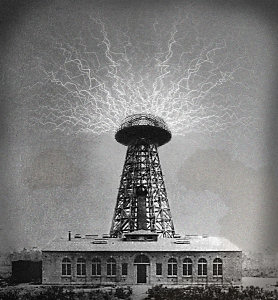When comic writer Matthew Inman, known online as The Oatmeal, joked about Nikola Tesla—he was serious.
So serious that in 2012 he partnered with The Tesla Science Center at Wardenclyffe to buy the late Tesla’s incomplete laboratory, Wardenclyffe Tower, through a crowdsourcing campaign on indiegogo.
The joke began on theoatmeal.com with an illustrated piece entitled, “Why Nikola Tesla was the greatest geek who ever lived.”
The piece argued that the Serbian-American scientist, Nikola Tesla, was the main reason that the world is currently (pun intended) powered by electricity. It points out that many people today think of Thomas Edison first when they think of the man who harnessed electricity.
The piece goes further to say that Tesla actually did Edison’s dirty work, but was never paid for his efforts. It credits Tesla as being the innovator behind neon lighting, the electric motor, and wireless communications— not Edison.
Inman’s passionate opinion of Tesla humorously bleeds through the entirety of the article while casting doubt and disdain toward Edison.
In 2013 Inman took that passion to indiegogo.com, a crowdsourcing site, and created a project called, “Let’s Build a Goddamn Tesla Museum.” The project asked the public to donate money to help “…buy back Nikola Tesla’s old laboratory, known as the Wardenclyffe Tower, and eventually turn it into a museum.”
The crowdsourcing effort raised more than $1 million in just nine days. From August 15 to September 29, the duration of the project, a total of $1,370,461 was raised to purchase the property. The original goal was $850,000.
Today, the Tesla Science Center at Wardenclyffe is an industrial cleanup site. The TSC website states:
“For safety reasons and to protect its historical integrity, TSC will keep the site closed for the foreseeable future, except for scheduled work and for occasional events. However, visitors can see the Tesla statue from New York 25A, behind which one can see the large octagonal foundation of Tesla’s former transmission tower and the brick laboratory building designed by Stanford White.”
Obviously there is no museum, yet, on the grounds. But a statue of Nikola Tesla was donated by the Serbian government in 2013, and proudly stands on the property where Tesla once worked.
A success? In the making…
This crowdsourcing project varied from the ‘Free the Files’ project in many ways. First, it required no man power. Inman simply asked for money and used his celebrity status to reach a large number of people.
Free the Files was more of a merit based project, concerned with the civil liberties of the people of the United States and actually started as something else, altogether.
In the Next Stop Design example, likely participants were already users of the system the government was attempting to improve. Participants were asked to offer ideas instead of money. They submitted designs they felt would improve the transportation infrastructure in their area.
In this sense it was a collection of ideas instead of money.
